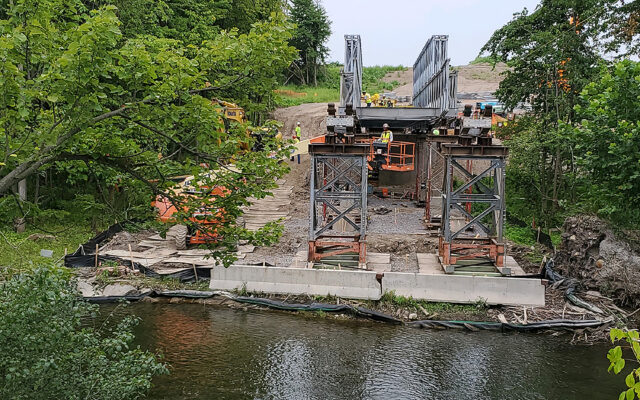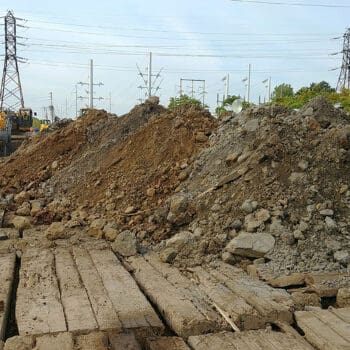Protecting the World We Live in During Large-Scale Utility Construction Projects

In today’s rapidly evolving world, where energy demands are growing exponentially, it is crucial to strike a balance between progress and the preservation of our planet. Environmental monitoring plays a vital role in achieving this delicate equilibrium, particularly in the context of the construction of utility-sized projects governed by 94-C and Article VII regulations in New York State. These guidelines ensure that energy infrastructure development proceeds in a manner that minimizes environmental impact during construction and protects the ecosystems we rely on.
Understanding CLCPA, 94-C, and Article VII
- The Climate Leadership and Community Protection Act (CLCPA) in New York State has provided funding initiatives and goals to work toward reducing greenhouse gas emissions, achieving net zero emissions, and increasing renewable energy use in New York State. The Act aims to achieve these goals through large-scale utility renewable energy projects and new or upgraded utility line infrastructure to enable renewable energy to reach the electrical grid.
- Introduced as a part of the New York State Department Public Service (NYSDPS) Law, Section 94-C mandates the development and implementation of responsible large-scale energy infrastructure by incorporating environmental considerations at every stage from permitting and design to construction.
- Article VII of the NYSDPS Law establishes a comprehensive framework for evaluating and permitting major utility projects. It ensures that projects of significant environmental and public importance undergo a rigorous review process.
In New York State, these projects are also required to have environmental and agricultural monitors on-site throughout construction as well as provide post-construction monitoring of certain disturbed areas. All environmental monitoring follows NYSDPS and New York State Department of Agriculture (NYSDAM) guidance and any site-specific permit requirements.
Environmental Monitoring and Its Significance
Environmental monitoring serves as a critical tool for managing the impact of utility-sized projects on our natural resources. By being on-site full-time during construction, environmental monitors can ensure project permits and applicable regulations are followed, which enables project stakeholders to make informed decisions and take necessary actions to mitigate any adverse effects.
The most important items reviewed in the environmental monitoring role during these projects are summarized below:
- Water Resources Monitoring: Monitoring water resources, including rivers, streams, and wetlands, ensures that utility projects do not pollute or permanently impact these valuable resources. It involves conducting regular field inspections during construction and implementing measures to prevent sediment release and potential contaminant impacts or mitigate their effects.
- Biodiversity Monitoring: Tracking the impact of the construction of utility-sized projects on local flora and fauna is crucial for preserving biodiversity. Environmental monitoring helps identify endangered, threatened, and rare species; protect habitats; prevent the spread of invasive species; and implement necessary measures to minimize disruption to ecosystems.
- Agricultural Monitoring: Environmental monitors help to ensure that soil is decompacted and retains nutrients, crop growth is not impacted, and drainage is maintained and restored within active agricultural fields along the project. Minimizing impacts to agricultural resources ensures property owners can continue to use their land for various agricultural activities during and after the construction and implementation of large-scale utility and renewable energy projects.
Compliance and Accountability
94-C and Article VII regulations emphasize compliance and accountability in utility-sized projects. Environmental monitoring plays a central role in ensuring adherence to these guidelines. By regularly monitoring and reporting environmental conditions, project developers and regulatory bodies can assess the project’s progress and take corrective action if needed.
- Mitigation Measures: Environmental monitoring helps identify potential issues early on, enabling the implementation of appropriate mitigation measures. These measures may include using eco-friendly construction materials, minimizing sediment pollution, or adopting alternative construction methods with less impacts on the local resources.
- Stakeholder Engagement: Environmental monitoring promotes transparency and encourages the involvement of stakeholders, including local communities, landowners, and environmental organizations. Regular reporting and open dialogue facilitate shared responsibility, enabling communities to contribute to the monitoring process.
Technological Advancements and Future Prospects
With advancements in technology, environmental monitoring has become more efficient, accurate, and accessible. Innovations such as remote sensing, satellite imaging, and data analytics allow for real-time monitoring and comprehensive assessment of environmental parameters. This progress opens new avenues for proactive environmental management and enables better decision-making during utility-sized projects.
Conclusion
Environmental monitoring is a cornerstone of responsible large-scale utility and renewable energy project development, ensuring that the environmental impact is minimized, and natural resources are preserved. Regulations such as 94-C and Article VII provide a framework for incorporating environmental considerations throughout the project lifecycle. By embracing environmental monitoring practices, stakeholders can protect the planet’s health while meeting the increasing energy demands of our society. Together, we can build a sustainable future that balances progress and environmental stewardship.
LaBella’s diverse team of experienced professionals has a proven record of delivering environmental monitoring services for our utility and energy partners. We are well versed in a range of wetlands and ecological, environmental permitting and review, and environmental construction support and compliance services to support your large-scale utility construction project. We are always available to guide clients through specific situations, so please feel free to reach out!

About the Author
John LanzEnvironmental Geologist
John’s experience includes Phase I and Phase II Environmental Site Assessments, performing investigation and remediation under the Brownfield Cleanup Program, and providing environmental and agricultural oversight during a variety natural gas pipeline, electric utility, and substation projects. Additionally, John has served as agricultural and environmental inspector during the construction of several large-scale Article VII utility projects. His involvement included conducting daily field inspections to ensure all work is performed in accordance with New York State Public Service Commission and New York State Agriculture and Markets regulations. John was also responsible for communicating with landowners, contractors, and regulatory agencies to ensure all aspects of the project are being executed correctly, as well as providing oversight of horizontal directional drilling and during the crossing of wetlands.
